
Owen Summers (June 13, 1850 – January 21, 1911) was a businessman, Oregon state legislator, and founder of the Oregon National Guard. Colonel Summers Park in Portland, Oregon, is named in his honor.

Owen Summers (June 13, 1850 – January 21, 1911) was a businessman, Oregon state legislator, and founder of the Oregon National Guard. Colonel Summers Park in Portland, Oregon, is named in his honor.
Owen Summers was born in Brockville, Canada West, on June 13, 1850, to parents John and Elizabeth Ann Summers, with Owen one of five children. The family soon moved to Chicago, Illinois, where John Summers entered the shoe business. In 1856, the parents and one daughter died in a cholera epidemic, leaving the remaining four children orphans. Owen went to a farm in Frankfort, Illinois, near Chicago. Owen worked on the farm, earning his room and board, as well as clothing, and attended school nearby when possible. [1]
In 1865 Owen, and four of his friends decided to join the Union Army in the American Civil War. They were fourteen years old. The recruiters refused to enlist them, six times. Then a Pennsylvania Dutchman agreed to take on the youngsters as their guardian, and the Army allowed them to join. On February 1, 1865 Owen Summers joined Company H of the 3rd Illinois Cavalry Regiment. Summers immediately shipped out to his unit, in Eastern Mississippi. Based on these dates, young Summers may have seen action in some battles before the end of the war, or perhaps he joined units that were ending their involvement. The Third Illinois Cavalry was reassigned to Missouri, to join battles against the Sioux Indians in Minnesota and the Dakotas. This assignment lasted during the summer of 1865. Summers and the regiment were mustered out in December, 1865. [1]
Returning to the farm after his stint in the Army, Summers later moved to Chicago in 1871. He was caught in the Great Chicago Fire, rescuing his new family and two others. After the fire, Summers performed contractor work in rebuilding the city. [1] He continued his contractor work on the West Coast, working in San Francisco and San Diego, before arriving in Portland, Oregon in 1879. He founded a crockery business with his brother-in-law, J. C. Olds, called Olds & Summers, and supplying crockery both wholesale and retail. The business flourished, as the two men became prominent local businessmen in Portland, Oregon. [1]
In 1896, Summers was selected as the United States Appraiser for the Port of Portland, Oregon. [2] In this role he was responsible for the examination, appraisal, and classification of all merchandise which is liable to customs duties upon importation or exportation from the Port. [3] He continued to serve in this role until his death, with the exception of the period of his military duties in the Philippines.
In 1886, serving in the Oregon State Assembly, Summers was instrumental in getting a bill passed that resulted in the state militia becoming the Oregon National Guard. One of the three new guard regiments was one Summers had organized in 1883 from veterans of the Civil War. At the opening of the Spanish–American War, the guard was consolidated into the 2nd Oregon Volunteer Infantry Regiment, with Summers as its commanding colonel. [2] In May, 1898, the Oregon Volunteers were the first regiment to sail for the Philippines in the Spanish–American War. Arriving in Manila in August they accepted the surrender of the Spanish Army of 15,000 soldiers. The Philippine insurgents who had been fighting the Spanish for several years expected to become the government of the new independent nation. Fighting now began between 11,000 American soldiers and the Philippine insurgents. [4] The Second Oregon Regiment fought in a number of major battles, and provided provost duties in Manila. During its term of service the regiment participated in forty-two engagements. The Second Oregon Regiment returned to the United States in 1899, and was de-commissioned from the Army. Owen Summers was honored with a brevet Brigadier General recognition. [2]
Owen Summers was married to Clara T. Olds in Portland, Oregon on July 23, 1880. Clara was the daughter of some of the original pioneers in Oregon. They had one child, Owen Summers Jr. Their son also joined the military, serving in World War II as a Major General, and having received multiple honors including the Silver Star and a Purple Heart. Mr. and Mrs. Summers were active in many civic and fraternal organizations in Oregon. [1]
Owen Summers died in Portland, Oregon, on January 21, 1911. He and his son are buried in Portland's River View Cemetery, where many Spanish–American War veterans are buried.

Wesley Merritt was an American major general who served in the cavalry of the United States Army during the American Civil War, American Indian Wars, and Spanish–American War. Following the latter war, he became the first American Military Governor of the Philippines.

Matthew Arlington Batson was a United States Army Officer who received the Medal of Honor for actions during the Philippine–American War. 1st Lieutenant Batson was awarded the medal for swimming the San Juan River under enemy fire. He was awarded his medal alongside Captain Hugh J. McGrath who performed the same feat. Batson is most noted, however, for creating the Philippine Scouts.
The Eighth Army Corps was formed on June 21, 1898, shortly after the outbreak of the Spanish–American War, in order to provide a ground contingent to exploit Commodore George Dewey's success in defeating the Spanish fleet in Manila Bay on May 1, 1898.

Colonel William Remsburg Grove was an American soldier who received the Medal of Honor. During the Philippine–American War, he charged against a group of rebels and assisted his commanding officer in killing or capturing all of them while armed with only a pistol. For this he was awarded the Medal of Honor in 1902.

The 1st Oregon Infantry Regiment was an American Civil War era military regiment recruited in Oregon for the Union Army. The regiment was formed in November 1864. At full strength, it was composed of ten companies of foot soldiers. The regiment was used to guard trade routes and escorted immigrant wagon trains from Fort Boise to the Willamette Valley. Its troops were used to pursue and suppress Native American raiders in eastern Oregon and the Idaho Territory. Several detachments accompanied survey parties and built roads in central and southern Oregon. The regiment's last company was mustered out of service in July 1867.

John Miller Drake was a Union Army officer in the 1st Oregon Cavalry and the 1st Oregon Infantry regiments during the American Civil War. He eventually reached the rank of lieutenant colonel. He led one of the first campaigns to respond to the threat Chief Paulina posed to settlers and rival Indians in central Oregon. Later he was a purchasing agent for the Oregon Railway and Navigation Company.

Isaac Rapp Brush was a decorated officer in United States Army with the rank of Major General. Brush commanded the 40th Infantry Division from 1942 to 1945 during its World War II involvement in the United States armed forces' liberation of the Philippines.
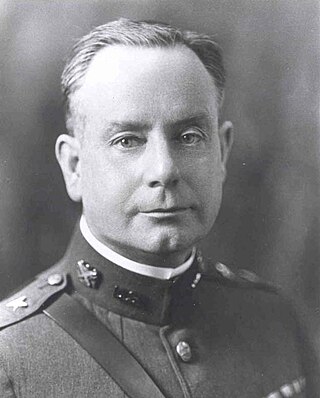
Creed C. Hammond was a major general in the United States Army. He served as Chief of the National Guard Bureau.
Owen Summers Jr. was a decorated U.S Army officer serving in both World War I and World War II.
Charles Wheaton Abbot Jr. was an American military officer of the late 19th and early 20th centuries. He was commander of the 1st Rhode Island Volunteer Infantry during the Spanish–American War and served as Adjutant General of Rhode Island from 1911 until his death in 1923. He was also a veteran of the Indian Wars, Philippine Insurrection and the First World War.

The 2nd Oregon Volunteer Infantry Regiment was a military regiment recruited in the U.S. state of Oregon during the Spanish–American War. As the first foreign war in U.S. history, it was the first time members of the Oregon National Guard had fought on foreign soil. The regiment also served with distinction in the Philippine–American War. At full strength, it was composed of 50 officers and 970 enlisted men. The regiment's last company was mustered out of service in August 1899.
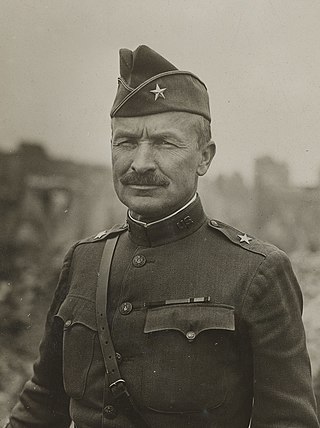
Major General Ulysses Grant McAlexander was an American officer who served in the United States Army. He was heavily decorated for valor, and is one of the iconic fighting men of the American Expeditionary Forces (AEF) during World War I. He is most famous for commanding the 38th Infantry Regiment during the Second Battle of the Marne in July 1918, and earning himself and the regiment the moniker "Rock of the Marne".

James Theodore Dean was a United States Army officer in the late 19th and early 20th centuries.

George King Hunter was a career officer in the United States Army. A veteran of the American Indian Wars, Spanish–American War, Philippine–American War, and World War I, he was a recipient of the Silver Star and attained the rank of Brigadier General.
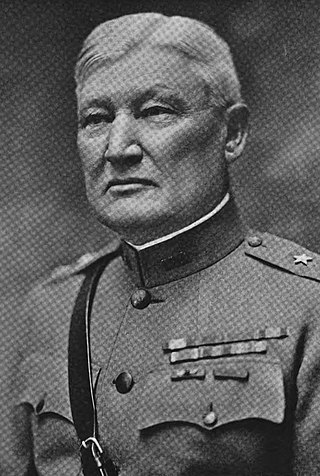
Edmund Wittenmyer was a career officer in the United States Army. A veteran of the Spanish–American War and World War I, in addition to several other conflicts, he attained the rank of major general and was most notable for his service as commander of 153rd Infantry Brigade, 77th Division and the 7th Division during World War I.
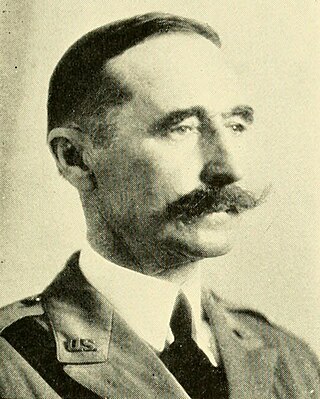
Walter C. Short was a career officer in the United States Army. A veteran of the Spanish–American War, Pancho Villa Expedition, and World War I, he attained the rank of brigadier general. Short was most notable for the organization and training of several units during the first World War, and his command of the 1st Cavalry Division between World War I and World War II.

Marcus Peter Miller was a career officer in the United States Army. A Union Army veteran of the American Civil War and a U.S. Army veteran of the American Indian Wars, Spanish–American War, and Philippine–American War, he served from 1858 to 1899, attained the rank of brigadier general, and was commended for gallantry during several Civil War battles, the Modoc War, Nez Perce War, and the Iloilo campaign of the Philippine–American War.
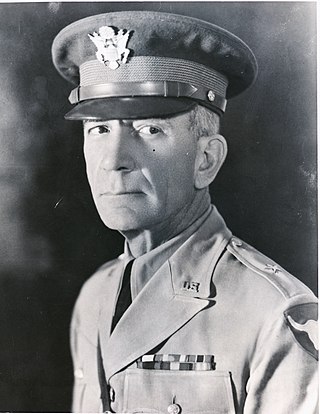
Casper H. Conrad Jr. was a career officer in the United States Army. A veteran of the Spanish–American War, Philippine–American War, Pancho Villa Expedition, and World War I, he served from 1895 to 1936 and attained the rank of brigadier general.

John H. Hughes was a career officer in the United States Army. He attained the rank of major general, and was most notable for his command of the Philippine Division (1937–1938) and the Philippine Department (1938–1939). A veteran of the Spanish–American War, Philippine–American War, and World War I, Hughes served for 43 years beginning 1897. After retiring in 1940, he was recalled to active duty for World War II and served at the Department of War from 1941 to 1945.

James M. J. Sanno was a career officer in the United States Army. A veteran of the American Civil War, American Indian Wars, Spanish–American War, Philippine–American War, he attained the rank of brigadier general, and was best known for his command of the: 4th Infantry Regiment; 2nd Brigade, 1st Division, Eighth Army Corps; 18th Infantry Regiment; 27th Infantry Regiment; and Department of Colorado. On July 30, 1903, Sanno was promoted to brigadier general in recognition of his long career of superior service, and he retired on July 31. Sanno died at Fort Oglethorpe, Georgia, on May 4, 1907. He was buried at Arlington National Cemetery.